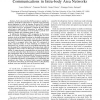Free Online Productivity Tools
i2Speak
i2Symbol
i2OCR
iTex2Img
iWeb2Print
iWeb2Shot
i2Type
iPdf2Split
iPdf2Merge
i2Bopomofo
i2Arabic
i2Style
i2Image
i2PDF
iLatex2Rtf
Sci2ools
WONS
2012
IEEE
2012
IEEE
Challenges and implications of using ultrasonic communications in intra-body area networks
Abstract— Body area networks (BANs) promise to enable revolutionary biomedical applications by wirelessly interconnecting devices implanted or worn by humans. However, BAN wireless communications based on radio-frequency (RF) electromagnetic waves suffer from poor propagation of signals in body tissues, which leads to high levels of attenuation. In addition, in-body transmissions are constrained to be low-power to prevent overheating of tissues and consequent death of cells. To address the limitations of RF propagation in the human body, we propose a paradigm shift by exploring the use of ultrasonic waves as the physical medium to wirelessly interconnect in-body implanted devices. Acoustic waves are the transmission technology of choice for underwater communications, since they are known to propagate better than their RF counterpart in media composed mainly of water. Similarly, we envision that ultrasound (e.g., acoustic waves at non-audible frequencies) will provide support for comm...
| Added | 25 Apr 2012 |
| Updated | 25 Apr 2012 |
| Type | Journal |
| Year | 2012 |
| Where | WONS |
| Authors | Laura Galluccio, Tommaso Melodia, Sergio Palazzo, Giuseppe Enrico Santagati |
Comments (0)

